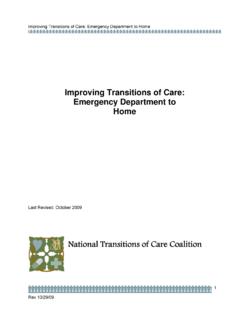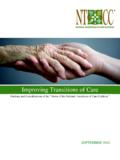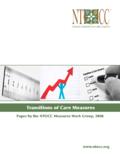Transcription of The National Transitions of Care Coalition - NTOCC
1 Improving on Transitions of care : How to implement and Evaluate a Plan 1 Improving on Transitions of care : How to implement and Evaluate a Plan The National Transitions of care Coalition Last revised: April 30, 2008 Improving on Transitions of care : How to implement and Evaluate a Plan 2 Acknowledgement This guidebook was written and compiled by Insight Therapeutics, LLC, ( ) and represents expert opinion. The Performance & Metrics Work Group of NTOCC provided strategic direction through its work in defining a framework for measuring transitional care , and review of various guidebook drafts. NTOCC Performance & Metrics Work Group Mary Fermazin, MD, MPA VP, Health Policy & Quality Measurement Health Services Advisory Group, Inc. (HSAG) Hussein Tahan, DNSc, RN, CAN New York Presbyterian Hospital James E. Lett II, MD, CMD Senior Medical Director Healthcare Process Improvement Lumetra Lisa McGonigal, MD, MPH Program Director National Quality Forum (NQF) Marci Weis, RN, MPH, CCM COO, care Management - Qualis Health Funding Acknowledgement This project was funded under a contract from NTOCC , which is chaired and coordinated by the Case Management Society of America and sponsored by sanofi-aventis LLC.
2 For more information Please visit the NTOCC website, , for additional contact information. Improving on Transitions of care : How to implement and Evaluate a Plan 3 CONTENTS 4 5 6 Evaluating and Improving Transitions of care in Your 8 Step 1. Select what you plan to 8 Step 2. Assess the current 9 Nursing Home to ED/hospital 12 Step 3. Determine your current level of 14 Step 4. Determining your intervention 21 Step 5. Implementing your intervention 25 Step 6. Determine your degree of 26 Step 7. Make any modifications necessary to the 28 31 Appendix A: EMS/Ambulance Transfer of Patient from a Nursing Home to 32 Appendix B: Hospital Receipt of Patient from Nursing 34 Appendix C: ED/Hospital to Nursing Home 43 Appendix D: EMS Transport of Patient to Nursing 48 Appendix E: Nursing Home Receipt of Patient from the 49 Appendix F: Evaluation: A Basic 53 Appendix G: Literature Review - Transitions from the nursing home to the 60 Appendix H: Institute for Healthcare Improvement Tips for Effective 63 Appendix I: NTOCC 64 Suggested Common/Essential Data Elements for Medication 64 My Medicine 64 Elements of Excellence in Transitions of care (TOC) 65 Appendix J: NTOCC Proposed Framework for Measuring Transitions of 66 Appendix K: Annotated Bibliography and 68 Improving on Transitions of care .
3 How to implement and Evaluate a Plan 4 Forward Remarks here from Cheri Lattimer, Exec director of CMSA NTOCC and its multidisciplinary team of health care leaders are committed to improving the quality of Transitions of care . Doing so requires attention to complex issues of health literacy, patient safety, medication non-adherence, treatment interventions, standards, guidelines, and performance measures. NTOCC s mission is to raise awareness about Transitions of care among health care professionals, government leaders, and consumers to increase the quality of care , reduce medication errors, and enhance clinical outcomes. To this end, NTOCC develops consensus regarding recommended actions that can be taken by all participants in the health care system to improve Transitions of care . NTOCC strives to provide a channel of communication to consumers for information when choosing health care options and also serves as a clearinghouse for tools and intervention resources to support providers and consumers to achieve safer and better Transitions .
4 NTOCC is committed to working in collaboration with all stakeholders and eliminating silos of care that diminish the ability of patients, particularly older adults, to receive the care coordination to which they are entitled. Further information about NTOCC is available on the organization s website at Improving on Transitions of care : How to implement and Evaluate a Plan 5 Introduction Patients face significant challenges when moving from one care setting to another within the fragmented health care system. As currently structured, the health care system does not meet the needs of many patients during Transitions between health care settings. The system s problems have culminated in medical errors and gross mismatches of health care resources to needs. (MR Chassin et al. The urgent need to improve health care quality: Institute of Medicine National Roundtable on Health care Quality, JAMA 1998;280:1000-05.) Oftentimes, episodes of care for serious illness or conditions involve numerous settings, both acute and long-term, and many highly specialized professionals.
5 These episodes generally occur with suboptimal communication between the various components and provide the context where resource utilization and quality care have met the greatest challenges. Transitional care connotes the scenario of a patient leaving one health care setting or provider and moving to another. Transitions often involve multiple caregivers and professionals. According to several studies over the last decade, patient safety and quality of care are being compromised, making care Transitions a National priority. Standardizing communication across settings will improve care Transitions by improving follow-up and reducing errors. A constant in all episodes of care is the patient, who, with sufficient education and empowerment, can proactively facilitate necessary communication and interaction between providers. In order to improve health care in this country, patients and providers must ensure better information exchange at all stages of the health care process, and patients and their caregivers should actively participate in a standardized communication plan.
6 In addition to the potential for poor care quality, Transitions of care issues pose a financial burden for the health insurers, the government, and patients. Studies show an increase in the cost of health care due to medication errors and readmissions after a patient experiences an adverse event, often considered related to poor communication in the transition process. Health care professionals and government leaders increasingly understand that improving the coordination of care among the various care settings can improve patient safety, quality of care , and health outcomes while avoiding significant costs. Making such improvements will be challenging and require significant and meaningful collaboration among health care providers, community members, and government regulators. In addition, patients and their families and caregivers need to take an active role in their health care and facilitate communication during Transitions .
7 Improving on Transitions of care : How to implement and Evaluate a Plan 6 Background The term " Transitions of care " connotes the scenario of a patient leaving one care setting ( hospital, nursing home, assisted living facility, SNF, primary care physician, home health, or specialist) and moving to another. The care transition frequently involves multiple persons, including the patient, family or other caregiver, nurses, social workers, case manager, pharmacists, physicians, and other providers. An optimal transition should be well planned and adequately timed. More often, however, communication between settings fails to provide all of the information needed for optimum quality of care . care coordination is a related but distinct concept that refers to the actual transition between two particular care settings. It involves the interaction of providers and health plan administrators across a variety of care settings to ensure optimal patient care .
8 Good care outcomes demand good, coordinated communication The lack of connectivity between providers in the health system has risen to the National consciousness. The Institute of Medicine (IOM) emphasizes that health care quality suffers "due not to a lack of effective treatments, but to inadequate health care delivery systems that fail to implement these treatments." (IOM, Priority Areas for National Action: Transforming Health care Quality (2003)). Fragmented care leads to an increase in both hard and soft costs financially, clinically, and at the patient level. The inefficiencies in the current system unnecessarily increase costs to patients, providers, payers, and employers. There exists significant evidence that poor Transitions : compromise patient safety and quality of care , place a significant burden on patients and their families and caregivers through inefficiencies, increase costs to patients, providers, payers.
9 Several efforts have studied how to improve Transitions of care . The Institute of Medicine and the Commonwealth Fund are just two organizations that have published reports outlining recommendations for improved care coordination. NTOCC has built upon these suggestions and developed their own recommendations outlined below. 1. Improve communications during Transitions between providers, patients, and caregivers. 2. implement electronic medical records that include standardized medication reconciliation elements. 3. Establish points of accountability for sending and receiving care , particularly for hospitalists and nursing home providers. Improving on Transitions of care : How to implement and Evaluate a Plan 74. Increase the use of case management and professional care coordination. 5. Expand the role of the pharmacist in Transitions of care . 6. implement payment systems that align incentives and include performance measures to encourage better Transitions of care .
10 Purpose and goal of this report The purpose of this report is to develop an implementation and evaluation outline for Transitions of care tools and resources developed by NTOCC . The plan is intended for institutions ready to make changes in the processes their facilities use to send and receive patients. The plan will include an educational component about Transitions of care , implementation manual, and evaluation methodology. These items will be incorporated into an example transition of care scenario. This implementation and evaluation plan will empower institutions to take the first step at measuring their own performance in Transitions of care and identify areas for improvement. It may be helpful to review the primer on evaluation (Appendix F) prior to getting started. NTOCC Tool Concept Paper Improving Transitions of care to Increase Quality and Patient Safety While Controlling Costs: The Vision of the National Transitions of care Coalition Improving on Transitions of care : How to implement and Evaluate a Plan 8 Evaluating and Improving Transitions of care in Your Institution Step 1.















